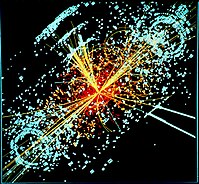
Photo from wikipedia
Enhanced beta (12–30 Hz) oscillatory activity in the basal ganglia (BG) is a prominent feature of the Parkinsonian state in animal models and in patients with Parkinson’s disease. Increased beta… Click to show full abstract
Enhanced beta (12–30 Hz) oscillatory activity in the basal ganglia (BG) is a prominent feature of the Parkinsonian state in animal models and in patients with Parkinson’s disease. Increased beta oscillations are associated with severe dopaminergic striatal depletion. However, the mechanisms underlying these pathological beta oscillations remain elusive. Inspired by the experimental observation that only subsets of neurons within each nucleus in the BG exhibit oscillatory activities, a computational model of the BG-thalamus neuronal network is proposed, which is characterized by subdivided nuclei within the BG. Using different currents externally applied to the neurons within a given nucleus, neurons behave according to one of the two subgroups, named “-N” and “-P,” where “-N” and “-P” denote the normal and the Parkinsonian states, respectively. The ratio of “-P” to “-N” neurons indicates the degree of the Parkinsonian state. Simulation results show that if “-P” neurons have a high degree of connectivity in the subthalamic nucleus (STN), they will have a significant downstream effect on the generation of beta oscillations in the globus pallidus. Interestingly, however, the generation of beta oscillations in the STN is independent of the selection of the “-P” neurons in the external segment of the globus pallidus (GPe), despite the reciprocal structure between STN and GPe. This computational model may pave the way to revealing the mechanism of such pathological behaviors in a realistic way that can replicate experimental observations. The simulation results suggest that the STN is more suitable than GPe as a deep brain stimulation target.
Journal Title: IEEE Transactions on Neural Networks and Learning Systems
Year Published: 2018
Link to full text (if available)
Share on Social Media: Sign Up to like & get
recommendations!